Jump to the section
- Key Learnings
- What is Leadership Style?
- Autocratic Leadership Style
- Democratic Leadership Style
- Laissez-Faire Leadership Style
- Transformational Leadership Style
- Transactional Leadership Style
- Servant Leadership Style
- Coaching Leadership Style
- Situational Leadership Style
- The Importance of Leadership Adaptability
- FAQs
- References
Key Learnings
#1
There’s No Single “Best” Leadership Style
Leaders match their approach to team needs and challenges. Situational leadership theory shows that success depends on adapting to team maturity and context.
#2
Each Style Has Strengths and Weaknesses
Autocratic works well in crises but stifles creativity. Democratic boosts collaboration but slows decisions. Laissez-faire inspires independence but risks low accountability.
#3
Adaptability Trumps Rigidity
Effective leaders shift tactics—coaching, delegating, or directing—to match skill levels. They evaluate each situation and adjust accordingly.
#4
Personality and Context Matter
Personality traits often influence style preference. Yet organizational culture, project needs, and team dynamics also shape leadership choices.
Have you ever thought about why one leader inspires a team to excel while another struggles to keep the team in harmony? The answer is in their approach to leadership. What is a leadership style, and why does it matter? A leadership style is defined as the behaviors and strategies that a leader uses to guide, influence, and motivate his or her team. Such a choice could transform team dynamics, drive innovation, or hinder progress if misaligned with the situation.
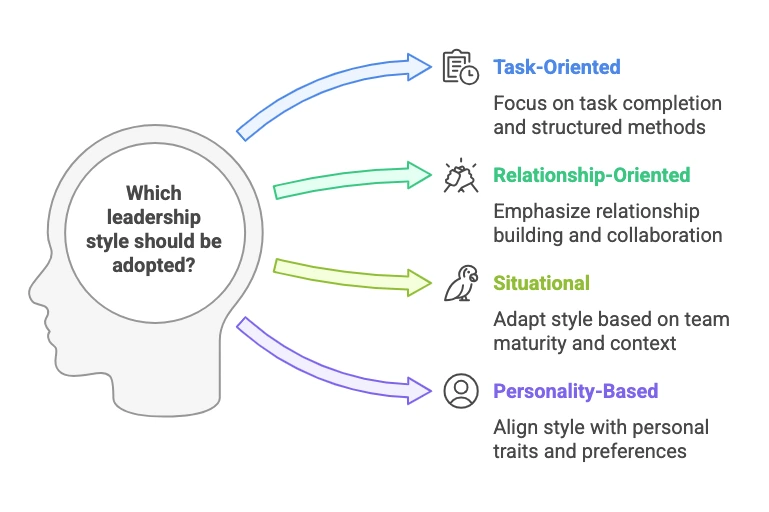
The question is which is the best style of leadership? The truth is that there is not a best one. Effective leaders tailor their style to the needs of their team and the challenge. For example, situational leadership theory shows that effective leaders change their style according to the situation. It depends on one’s level of readiness and maturity for a task in order to achieve the best outcomes [Alhadi, 2021].
There are innumerable types of leadership styles, each uniquely impacting team performance. Autocratic leadership styles focus on direct control—perfect for urgent decisions. On the other hand, democratic leadership styles encourage collaboration, fostering creativity and inclusiveness. Coaching leadership styles guide individuals toward growth, and servant leadership styles prioritize empathy and support [Moosa et al., 2023].
In this article, we will discuss these styles and more, which will help you find the approach that best fits your goals and team dynamics. By knowing the strengths and limitations of each style, you will gain the tools to lead with clarity, confidence, and adaptability.

🎙️ What is your Leadership Style? Find Your Perfect Approach 🚀
What is Leadership Style?
The leadership style is a specific way of providing direction, implementing plans, and motivating the team in the pursuit of achieving goals. It represents a consistent pattern of behavior that defines how a leader interacts with others and influences results (Hakim et al., 2021). Some are strategies leaders use to inspire their teams and surmount challenges—cornerstones of effective management [Ekiyor & Dapper, 2019].

A definition of leadership style has to account for its behavioral basis. Leaders are naturally inclined toward known behaviors, which become predictable ways of interacting with subordinates. These patterns enable leaders to relate to subordinates, build trust, and drive performance. For instance, a leader whose concern is mainly in task completion may rely on structured methods, while one whose concern is mainly in collaboration would stress relationship building [Hakim et al., 2021].
In situational leadership leaders are adapting their style to the maturity of the team, the context, and the organizational goals (reference: Henkel & Bourdeau, 2018). Therefore effective leaders adjust their leadership style depending on circumstances, ensuring their strategies meet the needs [Johnson et al., 2023].
Leadership is also dynamic and is built on context and personality. It can be regarded, from a different set of lenses, to be a skill, a social process, or a relationship between the leader and follower [Nanjundeswaraswamy et al., 2024]. Often, the person’s personality makes a choice regarding which style will be preferred, for example, extroverts toward transformational leadership, or conscientious individuals toward transactional [Panait, 2024].
Autocratic Leadership Style
The autocratic leadership style, also named authoritarian leadership, is characterized by a leader’s total control over decision-making and organizational processes. Leaders using this approach make decisions independently, set strict rules, and expect team members to follow instructions without question or objections. This style will stress structure, discipline, and precision, which makes it effective where quick decisions are needed or in cases where strict control is called for [Ekiyor & Dapper, 2019]. At its essence, autocratic leadership is based on command and obedience, with the leader providing direction while being entirely responsible for the organizational outcomes [Grover & Amit, 2024].
Key Characteristics of Autocratic Leaders
Autocratic leaders are very directive; they manage the activities and ensure that everything is geared towards their strategic objectives. They tend to be traditionalists, meaning that they depend on established systems and prefer structured environments to keep things predictable [Henkel & Bourdeau, 2018]. Such leaders would also tend to micromanage tasks by observing every minute detail for accuracy and conformity to their vision [Moosa et al., 2023]. Another hallmark of autocratic leadership is the emphasis on clarity; such leaders give clear instructions and well-defined processes to reduce misunderstandings among the team members [Cósta et al., 2023].
Advantages of Autocratic Leadership
One of the most notable advantages of the autocratic leadership style is that it makes it possible to make decisions very fast. Thus, centralized authority gives leaders the wherewithal to act decisively without consulting others—something that particularly comes in handy in crises or situations that require prompt action [Riak & Bill, 2022]. Thirdly, in autocratic leadership, there exists a chain of command that brings about clear role definitions and responsibility, thus averting ambiguity and making operations efficient [Ekiyor & Dapper, 2019]. Such leaders will, therefore, be keen on the goals of the organization, ensuring that the operations are successfully executed [Grover & Amit, 2024].
Weaknesses of Autocratic Leadership
Despite the mentioned strengths, the autocratic leadership approach is still not free of concerns. Its dependence on a centralized decision-making approach most frequently suppresses creativity and innovation since the other members of the group are seldom involved in any discussions or solutions to problems [Cósta et al., 2023]. This can create low morale, where employees feel undervalued and disengaged from the organization’s goals. Autocratic leadership can also create resistance from the team members. Team members feel ignored when decisions are being made by the leader directly affect their work [Moosa et al., 2023].
When to Use the Autocratic Leadership Style?
The autocratic style will work in specific situations—mostly where there is a requirement for immediate action or strict adherence to standards. In a time of emergency or crisis, where fast and decisive action is required, this style guarantees that a leader can do so without the delays caused by consultations [Riak & Bill, 2022]. It also brings benefits when one is dealing with new or inexperienced teams because giving clear and well-structured orders helps set the expectations and the processes. Involving strict compliance with rules and protocols, autocratic leadership ensures that not even a single rule is compromised, as required [Cósta et al., 2023]. The leaders who can judge the right situations for this style balance their strengths and limitations to achieve both efficiency and control.
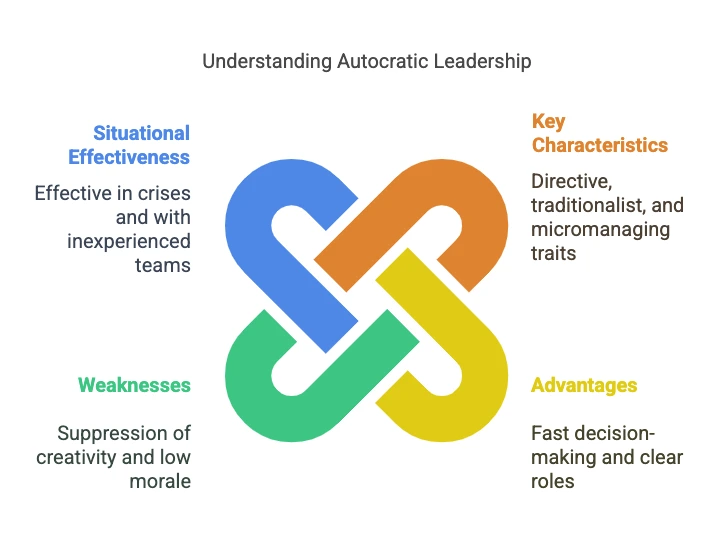
Democratic Leadership Style
The democratic leadership style is also popularly referred to as participative leadership. It is a style where leaders involve their subordinates in the decision-making process. Under this style, leaders encourage open communication and seek diverse opinions but retain the final authority to guide the team toward shared goals [Samaibekova & Kocherbaeva, 2019]. This creates an environment of free-flowing ideas, ensuring that everything is inclusive and shared in terms of responsibility for outcomes. While this approach fosters equality, it is the role of the leader to keep focus and ensure that there is adherence to organizational goals [Pal, 2022].
Critical Traits of Democratic Leaders
Democratic leaders are characterized as collaborative and inclusive. They respect the contributions of their team members and believe that the quality of decisions is enhanced through diverse ideas [Mbutu & Mongare, 2022]. Democratic leaders gain the trust and respect of their employees through empowerment. They create a supportive and motivating work environment [Samaibekova & Kocherbaeva, 2019]. Democratic leaders encourage open discussions, allowing team members to express their opinions and influence decisions while maintaining ownership of the results [Moosa et al., 2023]. Moreover, they appreciate every contribution, irrespective of the contributor’s rank or position, and hence there is a balanced approach to decision-making [Cósta et al., 2023].
Advantages of Democratic Leadership
The democratic leadership style encourages creativity and innovation since it uses different perspectives. The involvement of a team boosts morale and increases engagement since the employees are valued and become part of major decisions made by the organization [Moosa et al., 2023]. This participative approach generally brings forth improved problem-solving since it incorporates various perspectives in the decision-making process [Mbutu & Mongare, 2022]. By fostering a positive corporate culture, this style motivates employees to take ownership of their work and hence increase productivity and satisfaction [Samaibekova & Kocherbaeva, 2019].
Disadvantages of Democratic Leadership
This leadership style, though effective in some ways, may also delay timely decision-making because of the time spent seeking opinions and reaching a consensus. Conflicts among the members may arise because of disagreements that may disrupt team dynamics [Moosa et al., 2023]. Besides, the differences in expertise levels among the members may cause unequal influence, hence affecting the quality of decisions made [Cósta et al., 2023]. Democratic leadership also suffers when there is a requirement for a quick, decisive action as collaboration can slow things down [Grover & Amit, 2024].
When to Use the Democratic Leadership Style?
The democratic leadership style is best applied to an environment where there is a premium on collaboration and innovation. It works best where there is enough time to collect and incorporate inputs from members of a team so that there is greater buy-in toward decisions [Cósta et al., 2023]. Such an organization dealing with innovation-oriented projects or those involving creative problem-solving through diverse teams would find this style very suitable for them. It also excels with experienced and knowledgeable groups that can provide good insights and ideas on guiding the decision-making process [Samaibekova & Kocherbaeva, 2019].
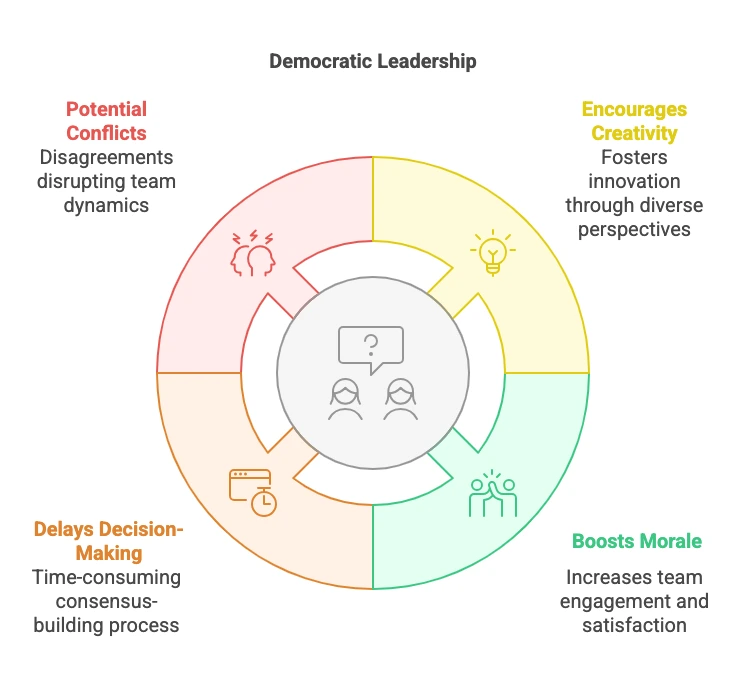
Laissez-Faire Leadership Style
The laissez-faire style of leadership is French for “let it ride.” In this style, leaders essentially delegate authority and decision-making responsibilities to the team. Leaders only provide minimal guidance, and employees are expected to take care of their responsibilities on their own accord [Abbasi, 2018]. Unlike directive leadership, leaders under laissez-faire emphasize their support only when needed and provide autonomy. They mostly do not interfere with day-to-day operations and let their teams find their solution and ways to succeed [Riak & Bill, 2022]. Though this style promotes independence, it needs very competent and motivated groups to be successful [Ekiyor & Dapper, 2019].
Characteristics of Laissez-Faire Leaders
Laissez-faire leaders are characterized by believing in freedom and autonomy. These leaders provide resources and tools critical to success but stay out of the way of day-to-day activities [Keerthana & Jayasri, 2024]. They rarely set expectations or performance goals, hence little clarity within some teams [Abbasi, 2018]. Often, their leadership is reactive—intervening only when problems appear—thus having low visibility of direct authority [Ekiyor & Dapper, 2019].
Advantages of Laissez-Faire Leadership
The laissez-faire leadership style comes out strong in an environment where the teams are experienced and highly motivated. It fosters innovation by giving freedom to the team members. The team can propose creative solutions. In this way, the style built on trust and responsibility creates positive dynamics in which employees feel valued and empowered to take initiative [Keerthana & Jayasri, 2024]. This kind of autonomy usually results in high job satisfaction and productivity for competent teams [Ekiyor & Dapper, 2019].
Disadvantages of Laissez-Faire Leadership Style
While it has its advantages, laissez-faire leadership can create some serious challenges. Without guidance, teams could find it difficult to coordinate and hold members accountable, which may lead to inconsistent performance. This style will not work with an inexperienced or unmotivated team that needs to be guided and controlled to perform [Keerthana & Jayasri, 2024]. The lack of proactive leadership may confuse and even stress the employees if expectations are not clear or if resources are not allocated properly [Abbasi, 2018].
When to Use Laissez-Faire Leadership?
Laissez-faire leadership is most appropriate for highly competent, independent teams that can take care of their responsibilities with minimal supervision. This style of leadership works well in creative fields or innovation-based projects where the freedom to experiment brings out the best results [Ekiyor & Dapper, 2019]. However, leaders should avoid this style in situations that need close supervision or with inexperienced teams since it hinders movement and productivity because there is no direction to follow [Keerthana & Jayasri, 2024].
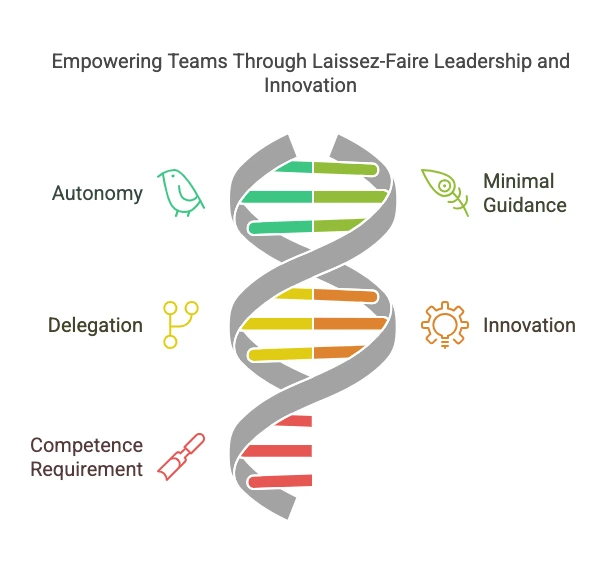
Transformational Leadership Style
Transformational leadership style is when leaders inspire and motivate others to exceed expectations towards a shared vision. This goes beyond the management of tasks, as it influences the values, beliefs, and attitudes of the members of an organization.
Therefore it creates meaningful change in individuals and the organization [Mbutu & Mongare, 2022]. Transformational leadership can empower their team by developing their potential and helping them to think outside of conventional boundaries. This style is more related to morale boosters, competence, and intrinsic motivation of employees to create a workplace where employees feel driven to innovate and strive for excellence [Pal, 2022]. Transformational leadership helps teams accomplish remarkable outcomes as personal goals merge with a powerful organizational vision [Abbasi, 2018].
Pros of Transformational Leadership
Transformational leaders articulate a vision that is dynamic and crystal clear, which energizes and unifies the team and creates a ‘belongingness’ feeling amongst team members with organizational objectives in goal convergence. Teams might feel inspired when the leader lays down the challenge and hence responds to a rally [Avolio et al., 1999].
Transformational leadership involves emotional support, intellectual stimulation, and personalized consideration. The leaders induce creativity while setting examples for the full development of team members. Transformational leadership empowers the team to solve problems in innovative ways. The team is encouraged to apply different approaches for developing valuable contributions toward the organization’s goals [Moosa et al., 2023]. Transformational leadership is strongly related to organizational innovation. Leaders break norms and encourage risk-taking. The focus is on creativity for positive change and competitive advantage [Nanjundeswaraswamy et al., 2024].
Disadvantages of Transformational Leadership
Transformational leadership requires a balance between vision and plan. Vision inspires, but is not enough. It needs actionable strategies to back it so that expectations are not unmet [Mbutu & Mongare, 2022]. This style will sometimes overlook short-term needs and focus a lot on long-term goals at the expense of immediate tasks [Henkel & Bourdeau, 2018]. Besides, its reliance on the leader’s charisma is unsustainable. When the influence of a leader wanes, so does the motivation and cohesion of a team—meaning that progress requires strong systems to be in place [Maxwell, 2020].
When to Use Transformational Leadership?
Transformational leadership is best used when there is a need for change or high uncertainty. It is excellent in environments where there needs to be much innovation or change. With this approach, transformational leaders inspire their teams to achieve difficult goals and overcome challenges in performance. This leadership is ideal for the culture of learning and growth of the employees toward professionalism and personal development [Mbutu & Mongare, 2022]. Transformational leaders can instill coherence in a group and can create extraordinary achievements [Maxwell, 2020].
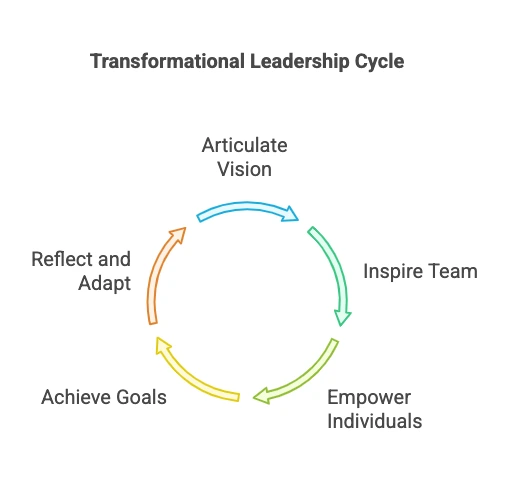
Transactional Leadership Style
Transactional leadership is a style or approach where leaders and followers exchange based on performance. More specifically, leaders set expectations, define roles, and even create a reward and penalty system to ensure these are adhered to. In this approach, the achievement of set or planned goals is tied to success, in which case it is rewarded through bonuses, promotions, or any other form of recognition. Failure to achieve goals will result in penalties or corrective actions [Moosa et al., 2023], [Mirzani, 2023].
This style thrives in structured and consistent environments and focuses on shorter-term results as opposed to long-term growth and innovation. In contrast, transactional leaders are committed to preserving the status quo and stability—results of which render this style effective in the achievement of set goals through predictable results [Costa et al., 2023].
Strengths of transactional leadership
One of the major advantages linked to transactional leadership is that it provides clarity. Leaders will convey expectations that allow employees to understand their roles and responsibilities.
Also, transactional leadership provides structure and stability through adherence to standard processes. This therefore brings uniformity in the execution of tasks and becomes very instrumental when dealing with operation or compliance-heavy environments. The performance-related reward focus also keeps motivating employees towards short-term goals hence keeping high short-term productivity for sales or manufacturing purposes amongst others [Mirzani, 2023], [Benmira & Agboola, 2021].
Weaknesses of Transactional Leadership
The transactional leadership style focuses more on extrinsic rewards. This could suppress creativity and reduce the intrinsic motivation of the team. Team members may be more interested in earning rewards rather than engaging in their tasks. This could lead to lower satisfaction and limited potential for innovation [Costa et al., 2023].
Furthermore, this style will often create a purely transactional relationship between the leaders and the team members, with no chance of personal development or long-term growth. Focusing on short-term goals will also prevent building up a motivated and innovative workforce, which makes organizations stagnant in the face of change [Moosa et al., 2023].
When to Use Transactional Leadership?
Transactional leadership is effective in situations where consistency and efficiency are required. It works well for the management of routine tasks and standardized processes. Leaders can use this style to achieve specific performance targets and maintain stability during repeatable and predictable tasks [Ekiyor & Dapper, 2019]. The transactional leadership approach should be balanced to create a comprehensive style. That integrates elements of other styles to boost creativity [Costa et al., 2023].
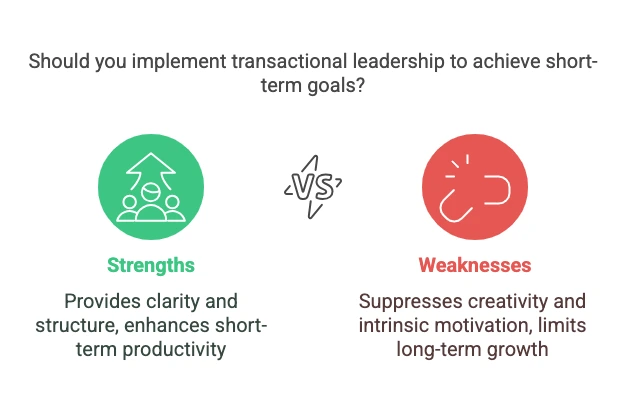
Servant Leadership Style
The servant leadership style emphasizes the development, well-being, and growth of the members of the team over the personal gain or authority of the leader. From this approach, it is believed that through the empowerment of others, a supportive environment can be created and authority can be attained through mutual respect and collaboration. Instead of trying to impose top-down control, servant leaders work to provide whatever resources and guidance their teams need to succeed. This leadership style is mostly consistent with decentralized organizational structures, which promote a culture of trust and shared responsibility [Pal, 2022], [Nanjundeswaraswamy et al., 2024].
Advantages of Servant Leadership
Servant leadership creates trust, respect, and loyalty in the members of a team since it focuses on the needs of the members of the team. This style will increase morale, and solidify the relationship between leaders and followers by creating a mutual respect environment. When people feel appreciated, they are likely to stay committed and loyal to the organization [Costa et al., 2023] [Maxwell, 2020].
This style could also create a positive and collaborative work environment. The emphasis on empathy and support creates a work environment that ensures the employees feel comfortable sharing ideas and working in harmony. Such environments enhance productivity while sparking creativity [Nanjundeswaraswamy et al., 2024]. On the other side, servant leaders actively nurture growth and empowerment among the employees by involving the team members in organizational decision-making. This will enable the individual to realize their full potential besides contributing much to the organization [Costa et al., 2023].
Disadvantages of Servant Leadership
While servant leadership encourages good team dynamics, it gives an impression of a lack of authority. Leaders who focus on collaboration might be viewed as indecisive by team members used to traditional forms of leadership [Pal, 2022].
Furthermore, the emphasis on collaboration might slow decision-making, especially in situations that require rapid change. Consensus-driven approaches may not suit environments that demand quick, unilateral decisions [Maxwell, 2020]. Lastly, servant leaders can also end up neglecting their own needs and professional development, which can burn them out or lower their effectiveness over time.
When to Use Servant Leadership?
The servant leadership style could work particularly in teams where there is a need for trust and collaboration. It works well in organizations with strong ethical considerations or value-driven cultures. It aligns with principles of service and mutual respect [Costa et al., 2023]. This leadership style is used to empower people and support their growth and skills development. By developing individuals and empowering them, servant leaders can build high-performing teams that can achieve long-term goals [Nanjundeswaraswamy et al., 2024].
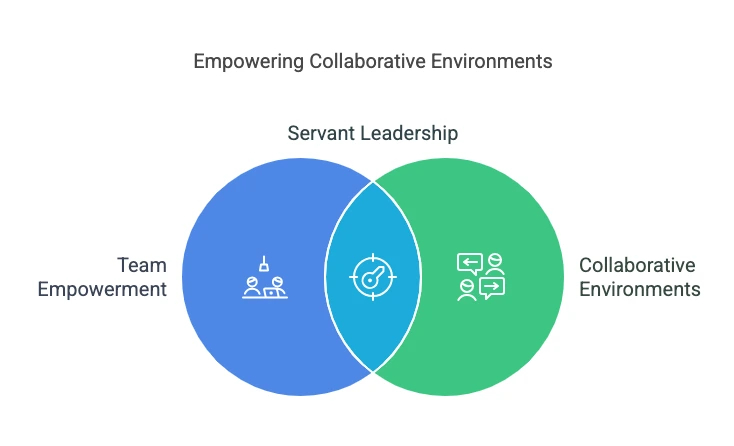
Coaching Leadership Style
The coaching leadership style is focused on developing skills, abilities, and potential team members. Leaders using this style act as mentors or guides in a close setting with their teams to help them realize their strengths and areas to improve. Instead of giving orders, coaching leaders give support, constructive criticism, and useful advice to their teams to perform effectively and efficiently. This approach is development-oriented, hence establishing an environment in which the individual members of the team are enabled to realize their full potential through learning and growing continuously [Pal, 2022], [Costa et al., 2023].
Advantages of Coaching Leadership
The coaching leadership style plays a vital role in developing skills. It empowers team members with what they need to excel in their respective roles by creating an atmosphere that first and foremost looks at personal and professional development. This style leads toward a culture of learning, enhancing performance, and job satisfaction. Team members will feel valued and supported, therefore leading to a more engaged and motivated workforce [Nanjundeswaraswamy et al., 2024].
Coaching leadership also improves the team’s overall performance, as supports and creates a collaborative environment. Leaders promote innovation, empower the members to take responsibility, and inculcate a culture of continuous development. This approach blends in very well with long-term growth-oriented and developmental organizations [Costa et al., 2023].
Cons of Coaching Leadership
Though coaching leadership has its benefits, it can also be very time-consuming. Leaders need to spend a lot of time mentoring, giving feedback, and shaping their approach toward individual needs. This may need resources, especially in high-pressure or fast-paced environments [Kesting et al., 2016]. This approach might not apply to every team or situation. Employees who are not motivated to develop or who need a more directive style of leadership would not benefit from coaching. Where decisions are required to be made or action taken urgently, coaching would slow this process down as it relies on collaboration and the long-term perspective [Hakim et al., 2021].
When to Use Coaching Leadership?
The coaching leadership style will work well in learning and development-focused organizations. It performs well where there is a need to develop the potential of the team members or to improve some particular skills. Leaders can adopt this style in preparing employees for higher-level responsibilities or in improving areas of targeted weaknesses. Organizations seeking innovation and continued success will gain from the embedding of coaching within their leadership culture [Pal, 2022], [Costa et al., 2023].
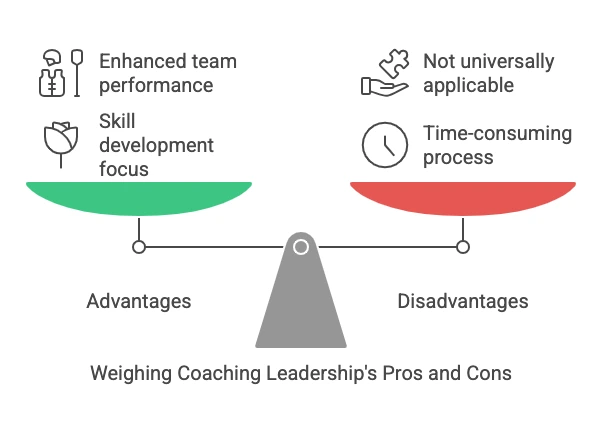
Situational Leadership Style
Situational leadership is the style of adaptive approach in which leaders change and adapt their practices of leadership based on the task at hand and the maturity level or readiness of their team. The style emphasizes that there isn’t a single leadership strategy that fits all situations. Instead, leaders assess competence and commitment among their teams and change behaviors accordingly to fill the gap for certain needs. By balancing task orientation with relational support, situational leaders make sure that both the objectives and the development of the team are addressed duly [Henkel & Bourdeau, 2018], [Hakim et al., 2021].
Four Styles of Situational Leadership
- Telling (Directing): This high-task, low-relationship approach is best suited for the inexperienced and confidence-less individual. Leaders give direct instructions while closely monitoring performance for compliance. Communication is one-way with an emphasis on structure and clarity [Henkel & Bourdeau, 2018].
- Selling (Coaching): High task and relationship focus—the style supports the employees who have some competence but need motivation or guidance. Leaders explain their decisions, seek input, and encourage buy-in while creating a collaborative and motivational atmosphere [Alhadi, 2021].
- Participating (Supporting): Leaders take a low-task, high-relationship approach when the team members are competent but lack confidence. Decision-making becomes shared with leaders involved in offering emotional support or encouragement [Hakim et al., 2021].
- Delegating: In low-task, low-relationship situations, leaders empower strong and dedicated people to take full ownership of the tasks. There is little need for close supervision since the team proves to be self-directed and confident [Henkel & Bourdeau, 2018].
When to Use Situational Leadership?
Situational leadership works well for teams where the difference in skills and readiness is apparent. Leaders are able to use a “telling” approach for new employees who don’t know how to perform a specific task and a “delegating” style for more experienced staff members, including those performing routine assignments.
Such flexibility ensures high performance and growth, even within the same team, since strategies should be changed according to specific tasks and peculiarities of an individual’s level of skills [Henkel & Bourdeau, 2018], [Alhadi, 2021].
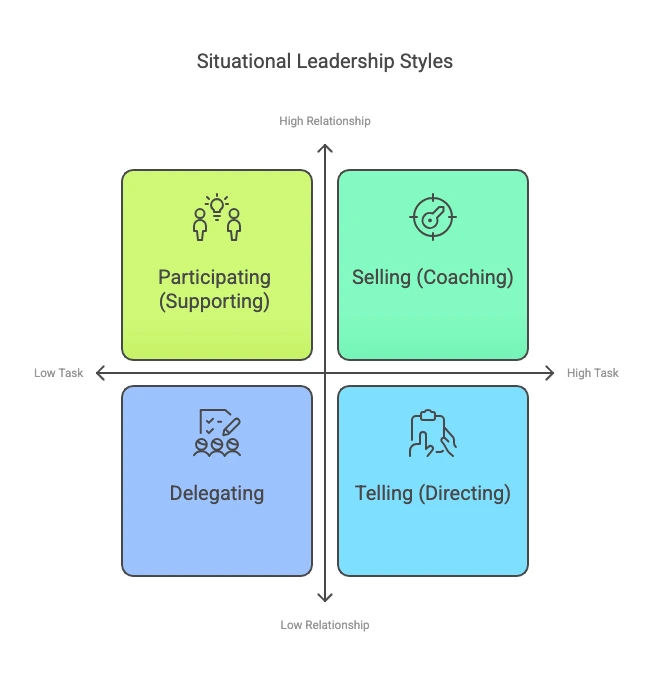
The Importance of Leadership Adaptability
Leadership needs a dynamic approach, and simply only one leadership style doesn’t work everywhere. Theories once sought a universal style but ultimately showed the necessity for flexibility and adaptability. Contingency theories, like situational leadership, put emphasis on the fact that effective leaders must adapt their approach to the needs of their teams and the demands of their environments.
Whether it is nurturing creativity in a team setting or using directive approaches for urgent projects, leaders succeed when they adapt their approach to situational factors [Henkel & Bourdeau, 2018], [Johnson et al., 2023].

The effectiveness of a leadership style is determined by the organizational culture, team dynamics, project complexity, and employee maturity. Strong leaders assess these variables to know when to provide support, autonomy, or direction. Equally, leaders will need to be self-aware, understanding their default tendencies and how these impact their teams to develop the agility necessary to move between styles with fluidity. This will not only increase the performance of the team but also nurture trust and development.
Leadership is an ongoing journey of self-discovery and growth. It does, of course, require an ethical foundation and a willingness to adapt. So by asking, “What’s your leadership style?” and embracing adaptability, leaders will put themselves in a position to inspire teams and overcome challenges for lasting success.
FAQs
It’s the consistent pattern of behaviors and strategies a leader uses to guide and motivate a team, influencing overall outcomes.
There isn’t one “best” style; the most effective leaders adapt to the team’s maturity, context, and goals.
There are the autocratic, democratic, laissez-faire, transformational, transactional, servant, coaching, and situational styles.
It centralizes decision-making in the leader, enabling quick action but often limiting team creativity.
It develops individual skills via guidance and feedback, boosting team performance and growth over time.
References
- Henkel, T.G., & Bourdeau, D.T. (2018). A Field Study: An Examination Of Managers’ Situational Leadership Styles. Journal of Diversity Management (JDM). https://doi.org/10.19030/jdm.v13i2.10218
- Grover, A., & Amit, D. (2024). The Big Five Personality Traits and Leadership: A Comprehensive Analysis. International Journal For Multidisciplinary Research. https://doi.org/10.36948/ijfmr.2024.v06i01.11820
- Hakim, A.L., Faizah, E.N., & Mas’adah, N. (2021). ANALYSIS OF LEADERSHIP STYLE BY USING THE MODEL OF HERSEY AND BLANCHARD. Journal of Leadership in Organizations. https://doi.org/10.22146/jlo.64390
- Karie, O.H., & Kulmiye, B.A. (2023). LEADERSHIP STYLES AND ORGANIZATIONAL PERFORMANCE: A LITERATURE REVIEW. European Journal of Social Sciences Studies.https://doi.org/10.46827/ejsss.v9i2.1574
- Ekiyor, R., & Dapper, E.M. (2019). Leadership Styles and Entrepreneurial Orientation. European Journal of Business and Management. https://doi.org/10.7176/ejbm/11-8-11
- Keerthana S., Jayasri V., (2024). Exploring the Effectiveness of Leadership Styles in Organizational Change Management. Shanlax International Journal of Management. https://doi.org/10.34293/management.v11is1-mar.7997
- Riak PhD, G.A., & Bill, D.B. (2022). THE IMPACT OF LEADERSHIP STYLES IN THE DEVELOPMENT. IJRDO – Journal of Social Science and Humanities Research.https://doi.org/10.53555/sshr.v8i11.5367
- Nanjundeswaraswamy, T.S., Nagesh, P., Bharath, S., & Vignesh, K.M. (2024). Leadership theories and styles—A systematic literature review and the narrative synthesis. Human Resources Management and Services.https://doi.org/10.18282/hrms.v6i3.3477
- Kesting, P., Ulhøi, J.P., Song, L.J., & Niu, H. (2016). The impact of leadership styles on innovation – a review. Journal of Innovation Management, 3, 22-41. https://doi.org/10.24840/2183-0606_003.004_0004
- Mbutu, P., & Mongare, W. (2022). The Art of Leadership – An Understanding. Journal of Human Resource and Leadership.https://doi.org/10.47604/jhrl.1512
- Samaibekova, Z., & Kocherbaeva, A.A. (2019). Leveraging universally desirable and undesirable leadership styles. Proceedings of the 4th International Conference on Social, Business, and Academic Leadership (ICSBAL 2019).https://doi.org/10.2991/icsbal-19.2019.7
- Drewniak, R., Drewniak, Z., & Posadzińska, I. (2020). Leadership Styles and Employee Expectations. EUROPEAN RESEARCH STUDIES JOURNAL.https://doi.org/10.35808/ersj/1768
- Moosa, M.D., Moosa, V., & Faheem, S. (2023). Prevailing Leadership Styles in Change Management: Evidence from Existing Research. International Journal of Professional Business Review.https://doi.org/10.26668/businessreview/2023.v8i5.1289
- Johnson, S., Crizzle, A., Lam, K., Toner, L., Marcovich, R., & Coulter, P. (2023). Intelligent Behaviour Analytics: A Novel Framework for Effective Leadership Style Transitioning. European Conference on Management Leadership and Governance.https://doi.org/10.34190/ecmlg.19.1.1918
- Benmira, S., & Agboola, M. (2021). Evolution of leadership theory. BMJ Leader, 5, 3 – 5. https://doi.org/10.1136/leader-2020-000296
- Avolio, B., Bass, B.M., & Jung, D.I. (1999). Re‐examining the components of transformational and transactional leadership using the Multifactor Leadership. Journal of Occupational and Organizational Psychology, 72, 441-462. https://doi.org/10.1348/096317999166789
- Jogulu, U. (2010). Culturally‐linked leadership styles. Leadership & Organization Development Journal, 31, 705-719. https://doi.org/10.1108/01437731011094766
- Maxwell, E. (2020). Perspectives: Leadership: What is it good for? Journal of Research in Nursing, 25, 175 – 178.https://doi.org/10.1177/1744987120908359
- Pal, R.K. (2022). Leadership: An Introductory Overview. International Journal of Research Publication and Reviews. https://doi.org/10.55248/gengpi.2022.3.10.17
- Mirzani, Y. (2023). A STUDY ON LEADERSHIP STYLES AND ITS IMPACT ON ORGANIZATIONAL SUCCESS. EPRA International Journal of Economics, Business and Management Studies.https://doi.org/10.36713/epra12138
- Alhadi, R. (2021). Situational Leadership Style: A Qualitative Study. Bulletin of Pedagogical Research. https://doi.org/10.51278/bpr.v1i2.231
- Ecler, J., & Terry, J. (2021). Leaders and Leadership. Archives of Community Medicine and Public Health.https://doi.org/10.17352/2455-5479.000138
- Marturano, A., & Gosling, J. (2007). Leadership: The Key Concepts.https://doi.org/10.4324/9780203099643
- Cósta, J., Padua, M.L., & Moreira, A.C. (2023). Leadership Styles and Innovation Management: What Is the Role of Human Capital? Administrative Sciences.https://doi.org/10.3390/admsci13020047
- Bratnicka, K. (2015). Relationship Between Leadership Styles and Organizational Creativity. Journal of Management and Business Administration. Central Europe, 23, 70 – 79.https://doi.org/10.7206/mba.ce.2084-3356.134
- Abbasi, S.G. (2018). Leadership Styles: Moderating Impact on Job Stress and Health. Journal of Human Resources Management Research.https://doi.org/10.5171/2018.322892
- Dias, M.D., Pan, J., Vieira, P., & Pereira, L.J. (2022). From Plato to e-Leaders: The Evolution of Leadership Theories and Styles. Journal of Economics and Business.https://doi.org/10.31014/aior.1992.05.02.420
- Panait, C. (2024). THE AMBIGUITY OF LEADERSHIP STYLES: A PSYCHOLOGICAL PERSPECTIVE. Review of the Air Force Academy.https://doi.org/10.19062/1842-9238.2024.22.1.10
